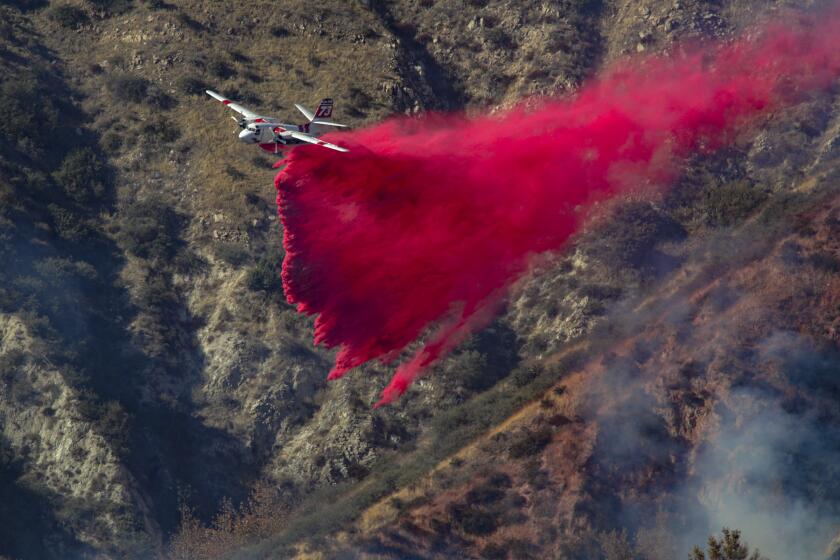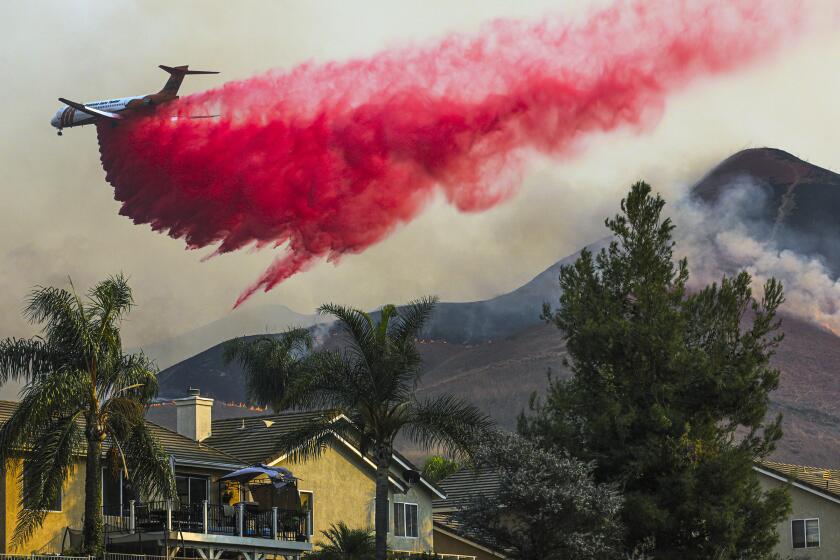
- Share via
- A new study by researchers at USC has found that a popular variety of fire retardant is laden with toxic metals
- Drawbacks aside, one fire chief said there’s no substitute for retardant when it comes to fighting wildfires.
It’s a scene that’s become routine with big blazes in the West. A plane dips low over a smoldering ridgetop and unleashes a ribbon of fire retardant, coating the hillside a bright pink. Onlookers cheer the display of firefighting prowess.
The U.S. Forest Service and other agencies each year drop tens of millions of gallons of fire retardant, mostly an ammonium phosphate-based slurry called Phos-Chek, around wildfires to coat vegetation and slow the spread of flames.
But a new study by researchers at USC has found that a popular variety is laden with toxic metals, and estimates retardant use has released 850,000 pounds of these chemicals into the environment since 2009. The results suggest the ecological consequences of retardant use merit further study, and that finding a cleaner product is probably worthwhile, said Daniel McCurry, associate professor of civil and environmental engineering at USC and one of the study’s authors.
The findings add to long-running concerns from environmentalists about the effects of retardant drops. But fire officials say the practice saves lives, and that the benefit of protecting ecosystems by minimizing fire spread outweighs the potential harms.
The debate is expected to intensify as wildfires increase in size and severity, in part because of climate change.
“There’s a pretty clear trend that wildfire frequency and intensity seems to be increasing, and the management of these wildfires, as far as I can tell, will continue to include aerial firefighting for the foreseeable future,” McCurry said.
Orange County Fire Authority Chief Brian Fennessy acknowledged drawbacks to use of retardant, including harm to aquatic life if it spills into waterways. But he said there’s simply no substitute for retardant when it comes to fighting wildfires.
The viscous substance is more effective than water — it hangs up on the vegetation and retains its flame-slowing properties even when it dries, he said. If his crews were no longer able to use it, he said, “I think you’d see fires get bigger — that’s the basic answer.”
“I think there’s a tradeoff there and a balance, and each situation being a little bit different, those considerations need to happen and they need to be talked about,” Fennessy said.
In the USC study, published in Environmental Science & Technology Letters, McCurry and his fellow researchers tested 14 fire suppressants. All were purchased on the open market because manufacturers declined to provide samples, he said.
Each contained at least eight heavy metals. One in particular — Phos-Chek LC-95W — had “potentially alarming” concentrations of several metals, including chromium, cadmium and vanadium, he said, adding that the substance could be classified as hazardous waste under federal and California regulations.
Chronic exposure to these metals has been linked to cancer, kidney and liver diseases in humans, but the potential ill effects on the environment are likely of more concern, particularly when retardant enters waterways, he said.
A lawsuit over the use of pink fire retardant could reshape how the U.S. Forest Service battles wildfires as they grow larger and more destructive.
McCurry described the retardant his team tested as the colorless version of the bright-pink Phos-Chek that’s dumped from aircraft. The pink stuff, LC-95A, is not available for consumers to purchase.
Perimeter Solutions, which manufactures Phos-Chek, said in a statement that the products are chemically different, and that LC-95W has never been used in aerial applications. All Phos-Chek retardants used in aerial firefighting must be fully qualified by the Forest Service, which requires extensive testing to meet strict safety standards, the statement said.
The Forest Service said it has used Phos-Chek LC-95W in aerial firefighting, albeit rarely. The formulation has been approved for both aerial and ground applications after passing multiple safety tests, including a toxicity characteristic leaching protocol developed by the Environmental Protection Agency to simulate how much of a substance’s toxic contents would be released into a landfill, the agency said.
The findings offer a new clue to a phenomenon geochemists have documented for years: heavy metal concentrations in streams and rivers tend to spike after nearby wildfires. For instance, after the Station fire burned in Angeles National Forest in 2009, researchers measured cadmium concentrations up to 1,000 times greater in the Arroyo Seco.
“There are lots of hypotheses for what the source of those metals could be, and this adds another dimension,” said Josh West, professor of earth sciences and environmental studies at USC. West was not involved in McCurry’s study but provided feedback before it was published.
There’s still more work to be done to learn the extent to which retardants leach into waterways and how much they contribute to these elevated metal levels, West said. It’s possible that they are one of several sources. His research has suggested that metals in air pollution settle on vegetation and are released into soils and waterways when that vegetation is burned.
While many fire experts say retardant is an invaluable resource for battling blazes, a growing number of environmentalists have raised concerns about the bright pink material.
McCurry’s team is working to learn more about whether the metals in retardant percolate into groundwater or run off into streams and rivers. One technique involves sampling soil from the San Gabriel Mountains, applying Phos-Chek, conducting controlled burns in a laboratory and using a student-built rainfall simulator to model how the metals travel.
They’re also trying to drill down on the source of heavy metal concentrations in streams after wildfires by using unique isotopic fingerprints to connect the chemicals to either retardant or other sources.
And in order to test the Phos-Chek formulation that’s not commercially available, his researchers have traveled to burn sites, including those scorched by the Post fire near Gorman and last year’s Highland fire near Aguanga, to sample soils that were sprayed with retardant, with plans to test the metal content.
Andy Stahl, executive director of environmental group Forest Service Employees for Environmental Ethics, said the study bolsters fears of heavy metal concentrations in Phos-Chek that had until recently been supported by circumstantial evidence. For instance, a Washington air tanker base was in 2016 cited by the state Department of Ecology for violating the cadmium, chromium and vanadium limits set by its waste discharge permit. A Forest Service report said it could not rule out potential heavy metal impurities in retardant, which was hosed down from firefighting planes.
Stahl’s group has sued the Forest Service over its retardant use multiple times dating back to 2003, resulting in the agency agreeing to map out buffer zones around vulnerable species habitat and waterways where it would refrain from dropping retardant absent a risk to public safety.
Most recently in 2022, the nonprofit filed a lawsuit in U.S. District Court in Montana after the Forest Service reported it had dropped more than 1 million gallons of retardant into those exclusion areas from 2012 through 2019.
As part of the lawsuit, the nonprofit sought to have the agency’s aerial retardant use suspended until it obtained a Clean Water Act permit to cover discharges into waterways, a process the EPA estimated would take 2 ½ years.
The judge last year ruled that the Forest Service must obtain a permit but that retardant drops could continue in the meantime because they are necessary to protect lives and property.
During the litigation, hundreds of pages of documents, including what purported to be an EPA list of contaminated air tanker bases, were left anonymously on the front porch of FSEEE’s lawyer in Missoula, Mont., Stahl said. An accompanying letter, claimed to have been written by a long-tenured Forest Service employee, called the presence of heavy metals such as cadmium and chromium in Phos-Chek “one of the worst kept secrets of the retardant industry.”
The Mountain fire could have been a second coming of the 2018 Woolsey fire or even the 2017 Thomas fire — if not for a few conditions that changed on the ground last week.
The threat of heavy metals in retardant may pose new regulatory challenges for the EPA as it writes the Forest Service’s Clean Water Act permit, Stahl said, adding that his group is looking at whether additional legal action is warranted based on the findings.
“We’re adding a potentially significant amount of toxic heavy metals when we dump retardant, no matter where we dump it in the watershed,” he said.










